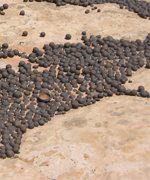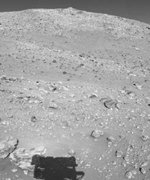As a former Martin-Marietta aerospace engineer, prolific author and founder of the non-profit Mars Society (1998), Robert Zubrin is regarded as the driving force behind the proposed Mars Direct mission to reduce the cost and complexity of interplanetary travel. The flight plan calls for a return journey fueled by rocket propellant harvested in situ, from the martian atmosphere itself.
As described in Zubrin’s book, The Case for Mars: The Plan to Settle the Red Planet, the Mars Direct concept eventually became a cornerstone of a frugal ‘living off the land’ approach to travel in NASA’s Design Reference Mission. The Design Reference Mission (DRM) covers Earth launch to Mars landing, Mars cruise to Mars launch, and Earth return. The mission entails sending cargo ahead, docking the crew at the space station, then meeting up with the stashed supplies once on Mars.
“For our generation and many that will follow, Mars is the New World,” writes Zubrin. The New York Times Book Review (Dennis Overbye) indicated how such an outline initially was greeted as breaking conventional wisdom about martian mission plans: “Part history, part call to arms, part technical manual, part wishful thinking, The Case for Mars … lays out an ingenious plan. ……one of the most provocative and hopeful documents I have read about the space program in 20 years.”
The Mars Society continues to grow across many countries with thousands of members interested in space advocacy, particularly how best to encourage the exploration and settlement of Mars. Notable among the Society’s members are science-fiction author, Greg Benford, and Academy Award winning director, James Cameron.
Astrobiology Magazine had the opportunity to talk with Robert Zubrin about the possibilities for terraforming Mars.
Astrobiology Magazine (AM): First off, should Mars be terraformed?
Robert Zubrin (RZ): Yes.
AM: Does Mars contain all of the elements needed to make the planet habitable, or will we have to import gases, chemicals, etc., from elsewhere? If so, then will Mars always need constant inputs to achieve habitability, or do you think that given enough inputs Mars would reach a tipping point and planetary processes would create a self-sustaining feed-back loop?
RZ: It appears that Mars does have all the elements needed for terraforming. The one outstanding question is nitrogen, whose inventory remains unknown. However theory suggests that Mars should have had an initial supply of nitrogen comparable to the Earth, and it seems likely that much of this is still there.
AM: How long will terraforming take? When you envision a terraformed Mars, what do you see?
RZ: If one considers the problem of terraforming Mars from the point of view of current technology, the scenario looks like this:
1. A century to settle Mars and create a substantial local industrial capability and population.
2. A half century producing fluorocarbon gases (like CF4) to warm the planet by ~10 C.
3. A half century for CO2 to outgas from the soil under the impetus of the fluorocarbon gases, thickening the atmosphere to 0.2 to 0.3 bar, and raising the planetary temperature a further 40 C. This will cause water to melt out of the permafrost, and rivers to flow and rain to fall. Radiation doses on the surface will also be greatly reduced. Under these conditions, with active human help, first photosynthetic microbes and then ever more complex plants could be spread over the planet, as they would be able to grow in the open. Humans on Mars in this stage would no longer need pressure suits, just oxygen masks, and very large domed cities could be built, as the domes would no longer need to contain pressure greater than the outside environment.
4. Over a period of about a thousand years, human-disseminated and harvested plants would be able to put ~150 mbar (millibars) of oxygen in the Martian atmosphere. Once this occurs, humans and other animals will be able to live on Mars in the open, and the world will become fully alive.
That’s the scenario, using current technological approaches. However technology is advancing, and 23rd Century humans will not conduct their projects using 21st Century means. They will use 23rd Century means and accomplish the job much faster than anyone today can suppose.
So if someone in the 24th Century, living on a fully terraformed Mars, should discover this interview, I believe that she will view it in much the same way as we today look at Jules Verne’s lunar mission design. We today look at Verne’s ideas and say “Amazing, a man living a hundred years before Apollo foresaw it — and not only that– launched his crew of three from Florida, and returned them in a capsule landing in the Pacific Ocean where they were picked up by a US warship, all as things actually happened. But launching people with heavy artillery – how 19th Century can you get?” So our 24th Century Martian historian studying this interview will smile and say; “Incredible. Here are people 300 years ago talking about terraforming Mars. But doing it with fluorocarbon gases and green plants –how 20th century can you get?”
AM: Who should the first human colonists to Mars be and how should they be chosen? Since Martian gravity is one-third of Earth’s, wouldn’t bone and muscle loss, along with radiation, make colonization a one-way journey? What are the implications of what, from an Earth-perspective, is exile?
RZ: Life is a one-way trip, and we are all permanently exiled from our past. In that sense Mars colonists, and all colonists, are no different from anyone else. It is just more apparent in their case, as in addition to leaving behind the time of their past, they also leave behind the place. But in so doing, they gain the opportunity to create a world where none existed before, and thus gain a form of immortality that is denied to those who are content to accept the world they are born in.
AM: If there’s life on Mars, how do we balance the Martian right to life with the human impulse to explore and extend our borders?
RZ: The basis of ethics needs to be of benefit to humanity. If there is life on Mars, it is microbial, and its interests can in no way be considered as commensurate with human interests. Those who argue otherwise strike a fashionable pose, but deny their arguments every day through their actions. If bacterial interests trump human interests, then mouthwash should be banned, chlorination of water supplies should be banned, and antibiotics should be banned. If bacterial interests trump human interests, then Albert Schweitzer and Louis Pasteur should be denounced for crimes against bacteria.
Now, in saying that ethics must be based in human benefit, we need not deny that preserving valuable environments in important. It is important to save the amazon rain forest, for example, because a world without an amazon rain forest would be a poorer inheritance for our descendants than one with one, and the degree of the impoverishment exceeds whatever value might be obtained in the short term from slash and burn agriculture. However, in the case of Mars, the calculation votes the other way, as a terraformed Mars, filled with life, cities, universities, used book stores, and yes, rain forests, would be a vastly richer gift to posterity than the current barren Red Planet. Clearly, just as anyone who proposed transforming the current Earth into a place like Mars would be considered mad, so those who, given the choice, would keep Mars dead rather than make it a place as wonderful as the Earth must have their sanity doubted.
There remains only the question of science. Surely we should avail ourselves of the opportunity to study native Martian life before we terraform the place. We surely will. Terraforming Mars will be a long term project, and should native Martian microbes exist, there will be ample opportunity to study it before terraforming takes place. There will also be opportunity to study how it adapts to warmer, wetter conditions and the presence of terrestrial microbes after terraforming takes place. Furthermore, if Mars actually is terraformed, there will be much more people on Mars to study every aspect of Mars, including both its native and immigrant life. So in fact, our knowledge of Martian biota will be increased by terraforming, not decreased.
AM: Humans sent to live on Mars will bring with them ideas on how to govern themselves, rules of conduct for living in society, economic motivations, and personality conflicts. How should the colonization of Mars be managed, and how should Mars be governed? Should the colonization of Mars be a cooperative effort among every nation, or should only those that financial contribute be in charge of the operation?
RZ: The Founding Fathers of the United States called our infant republic a “Noble Experiment,” a place where the grand liberal ideas of the Enlightenment could be given a run, and the idea of a government based on the rights on man could be tested to see if it could succeed in practice. Their Noble Experiment did succeed, and as a result became the model for a new and better form of human social organization worldwide.
Mars can, should, and will be a place for numerous new Noble Experiments. The well of human social thought has not yet run dry, nor do I believe that we have yet discovered the ultimate and most humanistic form of society possible. In the 22nd Century, as in the 18th, there will always be people who think they have discovered a better way, and need a place to go where the rules haven’t been written yet so they can give their ideas a try. For these, the Martian frontier will beckon. Many of their ideas will prove impractical, and their colonies will fail. But some of those who really have a better idea will succeed, and in doing so, light the way forward for all humanity.
So, to answer your question, I say that the colonization of Mars should not be managed at all, but be done through the joyful chaos of human freedom.
AM: Taking a leap into the future, let’s assume the technology, biology, sociology, and politics have all combined to create a unique sub-race of humanity on Mars. Generations of human beings have now been born, grown, bred and died on Mars. Who are these Martians?
RZ: In 1893, the great historian Frederick Jackson Turner wrote:
“To the frontier the American intellect owes its striking characteristics. That coarseness of strength combined with acuteness and inquisitiveness; that practical inventive turn of mind, quick to find expedients; that masterful grasp of material things, lacking in the artistic but powerful to effect great ends; that restless, nervous energy; that dominant individualism, working for good and evil, and withal that buoyancy and exuberance that comes from freedom — these are the traits of the frontier.”
I think that says it all. The pioneers of the Martian frontier will be the Americans of the future.
Original Source: Astrobiology Magazine


